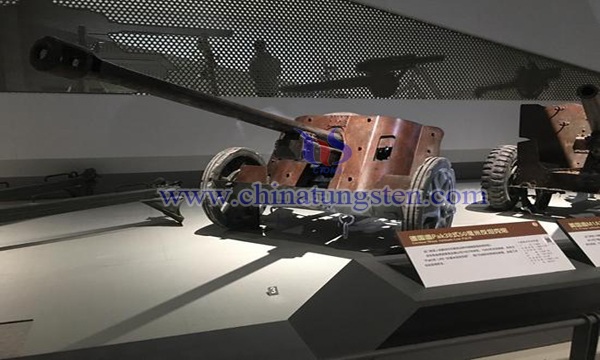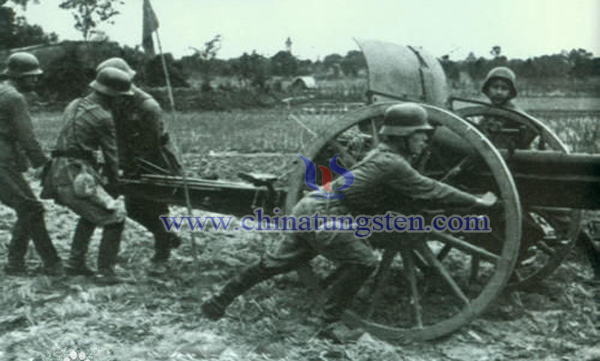When Chiang Kai-shek Desperately Encircled and Suppressed the Central Soviet Area, it was Because of Tungsten
- Details
- Category: Tungsten's News
- Published on Sunday, 24 March 2019 18:49
In the basement of the Beijing Military Museum, there is a line of anti-aircraft guns. The so-called anti-tank gun is the old name of the anti-tank gun. There are various types of anti-tank guns in Germany, Japan, France and the Soviet Union. One of the most famous is the German artillery of World War II, the Pak-38 50mm traction anti-tank gun.

This kind of artillery uses tungsten alloy armor-piercing projectile, which is a rare anti-tank gun in the early World War II that can pierce the front armor of Soviet T-34 and KV-1 tanks, not to mention those brittle-skinned tanks of the Japanese army. Nevertheless, the tungsten used by the Germans to manufacture armour-piercing bombs for Pak-38, as a strategic material, had long relied on China's exports, which led to a period of tungsten history.
In 1907, after German missionary Hu Liheng discovered tungsten deposits in Xihuashan, tungsten deposits were also found in the vicinity of Dayu County, Jiangxi Province, China. After 1928, the Red Army established the Central Soviet Area in southern Jiangxi. In the following years, tungsten sand trade became the largest source of foreign exchange revenue in the Central Soviet Area. A catty of high-quality tungsten sand can be replaced by "one and a half oceans". In the early Republic of China, a good Mu is worth 20 oceans! Comrade Mao Zemin, President of the Red Army Bank, is responsible for developing tungsten sand trade with Chen Jitang, a warlord of Guangdong Province. It has become an important financial source of the Central Soviet Area. There are no other competitors in China. It is a monopolistic and profitable trade that can support more than 100,000 Red Armies.
In preparation for the war of aggression, Germany under Hitler was constantly enriching its armaments. But at that time, German mineral resources were scarce, and strategic resources such as tungsten and antimony, which were indispensable for manufacturing heavy weapons, all depended on imports. At the same time, Germany was not very wealthy as everyone imagined at that time. Germany, which lacked foreign exchange, could hardly buy these resources in other countries, and the British obstructed it in every way, so Germany focused on China at that time.
At that time, China's tungsten sand production and export volume were the first in the world, coupled with the Chinese warlords'confrontation, it was possible to bypass Britain and buy from local warlords in China. The reason why the Germans did not look for Chiang Kai-shek was that there were no tungsten deposits in the area controlled by Nanjing at that time, while the main producing areas were around Guangdong, under the control of Chen Jitang and adjacent to Hong Kong, which made it easy to export. Another production area has a larger output in the southwestern part of the Yangtze River, but deep inland areas are more critical under the control of the Central Soviet Area and the Red Army. On the contrary, Chiang Kai-shek's supply capacity was the most limited, so the Germans did not seek Chiang Kai-shek at first.

In early 1933, Hans Klein, a German arms speculator, visited China for the first time as an attendant of the German Military Advisory Group in China. But instead of acting collectively with the members of the Advisory group, Hans quietly went to Guangzhou to find Chen Jitang, to talk about supplying mineral resources to Germany, and promised to build an arsenal for him.
However, after Hans'secret action was exposed, Chiang Kai-shek began to quarrel with the German military delegation in China, and the German general Falkenhausen, who took over as the new head of the Advisory group, helped Chiang Kai-shek speak a lot of good words. Chiang Kai-shek also sought out the German Consul General in Shanghai, Coliber, who was an early member of the Nazi Germany. He had suffered with Hitler and could speak well. He also strongly recommended Chiang Kai-shek. Therefore, under Hitler's direct intervention, German tungsten mining partners shifted from Chen Jitang in Guangdong to Chiang Kai-shek in Nanjing.
So how did Chiang Kai-shek, who had no mines in his hands, come up with tungsten? As a result, Chiang Kai-shek began his fifth "encirclement and suppression" of the Red Army, forcing the Red Army to embark on the Long March, and Chiang Kai-shek also controlled Jiangxi, China's largest tungsten mining area. At the same time, Jiang increased his encirclement of Chen Jitang in Guangdong, thus effectively controlling the export rights of tungsten mines.
This is also an extremely important economic reason why Chiang Kai-shek repeatedly launched "five encirclements and suppression" against the Central Soviet Area in spite of Japan's aggression in the three eastern provinces and North China, and he must drive the Central Red Army out of this area or eliminate it.
The Nanjing National Government expelled the Central Red Army and occupied all the tungsten mineral fields. Before the outbreak of World War II, there was a heated war with the German government. Because there was not much foreign exchange reserves between China and Germany, a credit contract of 100 million marks was signed in April 1936, which made it clear that China gave tungsten minerals and other resources, and Germany gave arms. Both sides'funds were drawn from this virtual credit contract of 100 million marks. The credit pool was returned to it as a de facto barter trade.
A large number of imported German sophisticated armaments eventually equipped several of Chiang Kai-shek's direct-line troops. The troops equipped with German weapons were called German machinists in Chinese history, including the Pak-38 50mm traction anti-tank gun introduced at the beginning of the article. These troops played an important role in the early stage of the Anti-Japanese War. However, due to the short time of Sino-German trade, the German machinists belong to Fengmelingjiao, which can not effectively prevent the Japanese aggressors from invading China.
So at any time, iron must be hard on its own, depending on others will always be subject to others. With the development and growth of New China, we no longer need to rely on tungsten ore for weapons to protect our country. At the same time, we have brought the advantages of rich tungsten resources to the extreme. Our military manufacturing level has been constantly improving, ranging from small bullets to tanks, missiles and aircraft. Many weapons can be produced by ourselves, and gradually turned to export. We have the same strength as the developed military powers in Europe and the United States (part of the article is taken from Sina Military).
- Tungsten Manufacturer & Supplier, Chinatungsten Online: www.chinatungsten.com
- Tungsten News & Prices of China Tungsten Industry Association: www.ctia.com.cn
- Molybdenum News & Price: news.molybdenum.com.cn
- Tel.: 86 592 5129696; Fax: 86 592 5129797; Email: sales@chinatungsten.com



 sales@chinatungsten.com
sales@chinatungsten.com